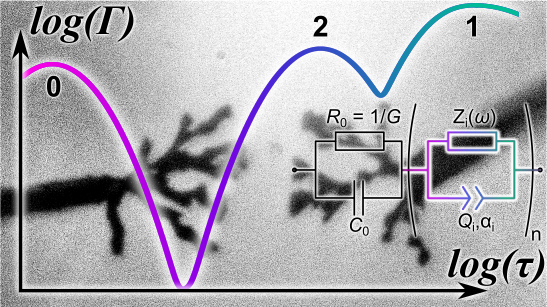











 Abstract: Conducting Polymer Dendrites (CPD) can engrave sophisticated patterns of electrical interconnects in their morphology, networking input with output nodes, from low-voltage spikes and with very minimal amounts of resources: they may unlock in operando man ufacturing functionalities for an electronics framework using metamorphism conjointly with electron transport as part of the information processing. The relationship between their structure and the information transport is still however very unclear and hinders the exploitation of the versatility of their morphologies to store and process electrodynamic information. This study details the evolution of CPD's circuit parameters with their growth and shape. By the means of electrochemical impedance spectro scopy (EIS), multiple distributions of relaxation times (DRT) are evidenced and evolve specifically upon growth. Correlations are established between the dispersive capacitance of dendritic morphologies and their growth duration, independently from exoge nous physical variables, such as distance, multi-component evaporation or aging. Deviation of the anomalous capacitance from the conventional Debye dielectric relaxation can be programmed within the morphology, as the growth controls the dispersion coeff icient of the dendrite's constant-phase elements relaxation. These results suggest that the fading-memory time window of pseudo-capacitive interconnects can practically be conditioned using electrogenerated CPD morphogenesis as an in materio learning mec hanism. This study confirms the perspective of using electrochemistry for unconventional electronics, engraving information with low voltage events in the physics of conducting polymer objects, and storing information in their morphology, accessible by i mpedance spectral analysis.
Abstract: Conducting Polymer Dendrites (CPD) can engrave sophisticated patterns of electrical interconnects in their morphology, networking input with output nodes, from low-voltage spikes and with very minimal amounts of resources: they may unlock in operando man ufacturing functionalities for an electronics framework using metamorphism conjointly with electron transport as part of the information processing. The relationship between their structure and the information transport is still however very unclear and hinders the exploitation of the versatility of their morphologies to store and process electrodynamic information. This study details the evolution of CPD's circuit parameters with their growth and shape. By the means of electrochemical impedance spectro scopy (EIS), multiple distributions of relaxation times (DRT) are evidenced and evolve specifically upon growth. Correlations are established between the dispersive capacitance of dendritic morphologies and their growth duration, independently from exoge nous physical variables, such as distance, multi-component evaporation or aging. Deviation of the anomalous capacitance from the conventional Debye dielectric relaxation can be programmed within the morphology, as the growth controls the dispersion coeff icient of the dendrite's constant-phase elements relaxation. These results suggest that the fading-memory time window of pseudo-capacitive interconnects can practically be conditioned using electrogenerated CPD morphogenesis as an in materio learning mec hanism. This study confirms the perspective of using electrochemistry for unconventional electronics, engraving information with low voltage events in the physics of conducting polymer objects, and storing information in their morphology, accessible by i mpedance spectral analysis.
Baron A., Hernández-Balaguera E., Pecqueur S.*


Abstract: Conducting Polymer Dendrites (CPD) are truly inspiring for unconventional electronics that shapes topological circuitries evolving upon an application. Driven by electrochemical processes, an electrochemical impedance rules signal propagation from one no de to another. However, clear models dictating their behavior in an electroactive electrolyte have not been identified yet. In this study, we investigate on CPD in an aqueous electrolyte by impedance spectroscopy to unify their signal transport with an e lectrical model, aiming to define a circuit simulation block to integrate these objects in systems for in materio information processing.
Baron A., Hernández-Balaguera E., Pecqueur S.
© 2019-2025 Sébastien Pecqueur